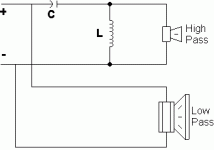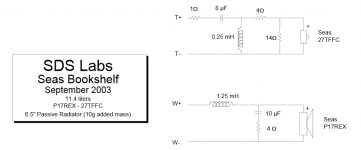Hi,
As you known, reversing polarity of tweeter is common for some crossover designs. Generally, we usually see a reversing tweeter polarity on both left and right speaker. But I was very wonder,
Is there reversing polarity only one side(left or right) exist in the world ? Has anyone ever seen or experienced
I've read on this forum for a long time, seems like somebody just mentioned he'd seen this condition on some JBL model.
In fact, I've faced with some weird story but I'll keep telling later.
Thank you
As you known, reversing polarity of tweeter is common for some crossover designs. Generally, we usually see a reversing tweeter polarity on both left and right speaker. But I was very wonder,
Is there reversing polarity only one side(left or right) exist in the world ? Has anyone ever seen or experienced
I've read on this forum for a long time, seems like somebody just mentioned he'd seen this condition on some JBL model.
In fact, I've faced with some weird story but I'll keep telling later.
Thank you
Last edited:
It's also done in the mixing studio to enhance/widen stereoeffect (not as simple as just reversing the signal, but a bit more complex phase distortion). To me it still sounds annoing. But since it's present on probably most modern recordings it's something we hav to live with. But to do it on a stereospeaker for stereosignal seems to me, to be a fault.
Aha, got some replies. 
From now on, I'm gonna tell my story that has been outlined above.
I have a pair of 80's Japanese speaker, Denon SC-C3, but because of an accident, their woofers were blown . So, I decided to replace them with a new pair of SEAS H602 P17REX/P.
. So, I decided to replace them with a new pair of SEAS H602 P17REX/P.
After disassembling the speaker, I noticed that the right tweeter was wired reverse polarity but the left was precisely wired. I was a little skeptical but didn't mind too much because I thought it maybe done by my previous owner(my uncle) when checking it or something like this.
First time installing the new woofers, I had new wiring on the tweeters. Both were wired precise polarity. Then, it's time to test! ...The result was the sound at X-over point was a little dip and too diffusing and when listen for a long time it feel annoyed and also exhausted.
So, I tried to added new wiring for a second time. I switched the tweeters to reversed polarity on both. And the result was... the sounds like the first time! but plus a little peak at X-over point instead.
Finally, I decided to bring it back to the original (reverse on the right and precise on the left). And the result was... it sounds so smooth and has certain directions.
What do you think about it ? Is it weird or not ?
Anyone who can explain this ?
Note : The crossover diagram is on an image below and is the same for the left and right speaker.
From now on, I'm gonna tell my story that has been outlined above.
I have a pair of 80's Japanese speaker, Denon SC-C3, but because of an accident, their woofers were blown
 . So, I decided to replace them with a new pair of SEAS H602 P17REX/P.
. So, I decided to replace them with a new pair of SEAS H602 P17REX/P. After disassembling the speaker, I noticed that the right tweeter was wired reverse polarity but the left was precisely wired. I was a little skeptical but didn't mind too much because I thought it maybe done by my previous owner(my uncle) when checking it or something like this.
First time installing the new woofers, I had new wiring on the tweeters. Both were wired precise polarity. Then, it's time to test! ...The result was the sound at X-over point was a little dip and too diffusing and when listen for a long time it feel annoyed and also exhausted.

So, I tried to added new wiring for a second time. I switched the tweeters to reversed polarity on both. And the result was... the sounds like the first time! but plus a little peak at X-over point instead.

Finally, I decided to bring it back to the original (reverse on the right and precise on the left). And the result was... it sounds so smooth and has certain directions.
What do you think about it ? Is it weird or not ?
Anyone who can explain this ?
Note : The crossover diagram is on an image below and is the same for the left and right speaker.
Attachments
Last edited:
There are some negative polarity solutions with third order butterworth slopes. It's to do with the crossover wavelength on flat baffle.
But your SEAS driver running fullrange is going to have some bad cone breakup around 6kHz. That is the source of any listening fatigue IMO. Flipping tweeter phase might make it more or less audible due to reinforcement.
I think your filter was inappropriate, in other words. Swapping bass drivers needed more work than you anticipated. The natural rolloff may have been different and you really needed to add a bass coil.
But your SEAS driver running fullrange is going to have some bad cone breakup around 6kHz. That is the source of any listening fatigue IMO. Flipping tweeter phase might make it more or less audible due to reinforcement.
I think your filter was inappropriate, in other words. Swapping bass drivers needed more work than you anticipated. The natural rolloff may have been different and you really needed to add a bass coil.
There are some negative polarity solutions with third order butterworth slopes. It's to do with the crossover wavelength on flat baffle.
But your SEAS driver running fullrange is going to have some bad cone breakup around 6kHz. That is the source of any listening fatigue IMO. Flipping tweeter phase might make it more or less audible due to reinforcement.
I think your filter was inappropriate, in other words. Swapping bass drivers needed more work than you anticipated. The natural rolloff may have been different and you really needed to add a bass coil.
system7,
Yes, Now I've already added a bass coil to my SEAS woofer. In fact, it's a baffle step compensation circuit (using 1.8mH non-ferrite core parallel with 6.1 ohm resistor).
But those problems with tweeter's polarity are still exist as I tried to do an experiment on swapping the tweeter's polarity again.
Last edited:
There are so many unknown in this equation. You can't just swap woofers, and I will still argue for that reverse polarity on just one tweeter is wrong
Kjeldsen,
Yes, I know it went wrong. But as I told above I've heard somebody said he'd seen this condition on some JBL models. Thus, I came here to ask for an explanation about this weird story.
Last edited:
That RL BSC circuit won't do much rolloff at the top, if any. You'd usually be looking at around 2mH series and about 5uF shunt.
I'm sure Troels Gravesen did a design with that famous old SEAS H602 P17REX/P polycone. Just can't find it.
I'm sure Troels Gravesen did a design with that famous old SEAS H602 P17REX/P polycone. Just can't find it.
That RL BSC circuit won't do much rolloff at the top, if any. You'd usually be looking at around 2mH series and about 5uF shunt.
I'm sure Troels Gravesen did a design with that famous old SEAS H602 P17REX/P polycone. Just can't find it.
system7,
Thanks for advising but there's no problem with the woofer's response. Cause, fortunately, a Seas has roll-off itself matched to the tweeter's x-over point incidentally(about 4kHz)
Last edited:
Kjeldsen,
Yes, I know it went wrong. But as I told above I've heard somebody said he'd seen this condition on some JBL models. Thus, I came here to ask for an explanation about this weird story.
I know the story, but that is only that vintage JBL have different markig of phase than other makers. Not, that only one tweeter should reversed
Oh well.... once (by a stupid mistake -mismarking new tweeter cable) I've listened to an otherwise excellent pair of speakers with ONE reversed tweeter for weeks. It was an interesting effect, a kind of widened but sometimes unstable stage presentation, but overall it was not unlistenable. Actually it was hard to pinpoint what was wrong with it, I just had this gut-feeling, until one day I rechecked everything with a DMM, and discovered my mistake. As far as I know no commercial design was ever made with intentionally reversed ONE tweeter in a pair, unless by similar mistake.
Just for the record, here's a goodish looking lowish 2.2kHz filter for the polyconed and phaseplugged SEAS P17REX and SEAS 27TFFC from SDS Labs.
With a 1.5mH coil, you'd use an 8.2uF/4R shunt. Wouldn't be much different. I don't care what you say, running drivers fullrange is just not my definition of smooth!
With a 1.5mH coil, you'd use an 8.2uF/4R shunt. Wouldn't be much different. I don't care what you say, running drivers fullrange is just not my definition of smooth!
Attachments
No one can hear a phase diffrence, that's one of the things the human ear lacks.
Clark Johnsen devoted an entire book to the audibility of the absolute phase ("The Wood Effect"), based on his experimentations and experience on the subject. I can assure you, with a little "training" of your ears, you can definitely differentiate between the "right" and "wrong" polarity of a given system, and recording -as you know many records and audio gear inverts phase several times before reaching the speakers. It is not all the same whether an audio signal starts with a compression, or rarefaction wave through the air. In that sense ABSOLUTE polarity is clearly audible......
yes indeed all amplifiers invert the singal several times until it is enough amplified and is in with phase with the original signal. Anyway i doubt that many can hear that diffrence, maybe someone who has trained his ears for a long period of time. Most of the time people will say there is a diffrence because someone told them the signal is inverted, not because they heard it. So it's a discussable thing.
- Status
- This old topic is closed. If you want to reopen this topic, contact a moderator using the "Report Post" button.
- Home
- Loudspeakers
- Multi-Way
- Is it weird or not ? Reversing one tweeter-polarity.

